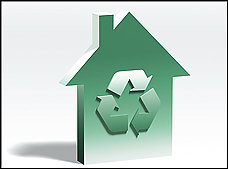Lower the Bills With 5 Energy Savers

Washington Post Staff Writer
Sunday, October 14, 2007
This time of year, homeowners' thoughts often turn to ways of keeping their heating bills in check as the weather cools.
If the brisk air isn't enough to motivate you, the federal government is kicking in a little incentive. Tax breaks for installing and replacing energy-efficient doors, windows, water heaters, and heating and cooling systems are set to expire at the end of the year.

But boosting your home's energy efficiency need not empty your savings account or hand your house over to contractors for a week.
"Different homeowners need to do different things, in different orders," said Peter Van Buren of TerraLogos Green Home Services in Baltimore.
Here are five things every homeowner can do now to cut energy bills this winter.
Unholster the caulk gun and make ready the weather-stripping. So boring, so basic and so absolutely necessary, say energy efficiency experts. Air leaks around windows and doors, in particular, can be huge energy wasters. They're easy and inexpensive to fix. Other common trouble spots include outdoor faucets, dryer vents, and vents for bathroom and kitchen fans.
Swap out a few light bulbs. Shorter days mean increased need for lighting. As bulbs go out in your home, replace them with compact fluorescent bulbs, which use 75 percent less energy than their incandescent counterparts. As a bonus, they also last up to 10 times as long, so you'll make fewer trips up and down the stepladder to replace them.
Install a programmable thermostat. Why heat the house when no one is in it? But by allowing you to sync the heating and cooling systems with your daily and weekly habits, an Energy Star programmable thermostat can save you about $150 in the first year of operation. Most models sell for less than $100, so the return on your investment is quick. Pick one that's easy to use.
Unload your old clothes washer. Get a new one with the Energy Star rating and save more than $100 a year on utilities, compared with a washer made before 2004. Qualifying washers use 40 percent less energy than standard washers and about half as much water. But you can hang on to the old dryer until it expires — most dryers use similar amounts of energy and none has earned the Energy Star rating.
Hire an energy auditor. A professional inspector can pinpoint the energy wasters in your home and suggest the most cost-effective improvements. That can be especially helpful if you've already covered the obvious points of energy waste. In the Washington area, expect to pay several hundred dollars for the inspection and report. To find leaks, the inspector will perform what's called a "blower door test," in which a big, calibrated fan is sealed into an outside door. When it's turned on, the effect is like having a 20 mile per hour wind huffing, puffing, trying to blow into the house.
Feel a draft?

